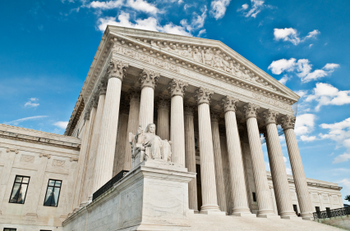
Unanimous court authorizes direct judicial review of EPA water pollution orders.
Under a unanimous decision issued Wednesday by the U.S. Supreme Court, persons subjected to cease and desist orders by the U.S. Environmental Protection Agency (EPA) for allegedly polluting U.S. waters are now able to go directly to federal court to challenge those orders.
The Court found that the Administrative Procedure Act (APA) entitles persons to seek judicial review of such “administrative compliance orders” and that nothing in the authorizing statute, the Clean Water Act (CWA), explicitly or implicitly precludes judicial review of these orders under the APA.
The case was brought by an Idaho couple, Mike and Chantell Sackett, who attempted to build a home on their property near Priest Lake, Idaho, where the EPA claimed there existed protected wetlands. In its compliance order, EPA claimed that the Sacketts had illegally dumped dirt into the alleged wetlands on their property in the construction of their home. The couple went to court to challenge EPA’s jurisdiction over their property, but the case was dismissed by the lower courts for being filed prematurely, since EPA had yet to initiate a court action against the couple.
The APA provides for judicial review of “final agency action for which there is no other adequate remedy in a court.” The Supreme Court held that the type of administrative compliance order at issue in the case was a final agency action. Not only did the order have “legal consequences” because it assessed daily civil penalties for failure to comply, but it was also a “‘consummation’ of the agency’s decisionmaking process” because the order’s findings and conclusions were not subject to further review by EPA.
After describing the absence of a sufficient judicial remedy to challenge the compliance order, the Court refused several EPA arguments claiming that the CWA preempted the APA judicial review provision. The Court concluded that there is no evidence that Congress intended to exclude CWA administrative compliance orders from judicial review, so the petitioners could challenge EPA’s fine for starting home construction.
Justice Scalia, writing for the Court, dismissed EPA’s suggestion that granting judicial review of compliance orders will discourage the agency from using these orders, stating that “there is no reason to think that the Clean Water Act was uniquely designed to enable the strong-arming of regulated parties into ‘voluntary compliance’ without the opportunity for judicial review.”
Justice Ginsburg and Justice Alito agreed with the Court’s decision but separately filed concurring opinions. For example, while noting that judicial review of CWA compliance orders under the APA was “better than nothing,” Justice Alito strongly criticized Congress’s failure to, in his opinion, “do what it should have done in the first place,” namely, “provide a reasonably clear rule regarding the reach of the Clean Water Act.”



